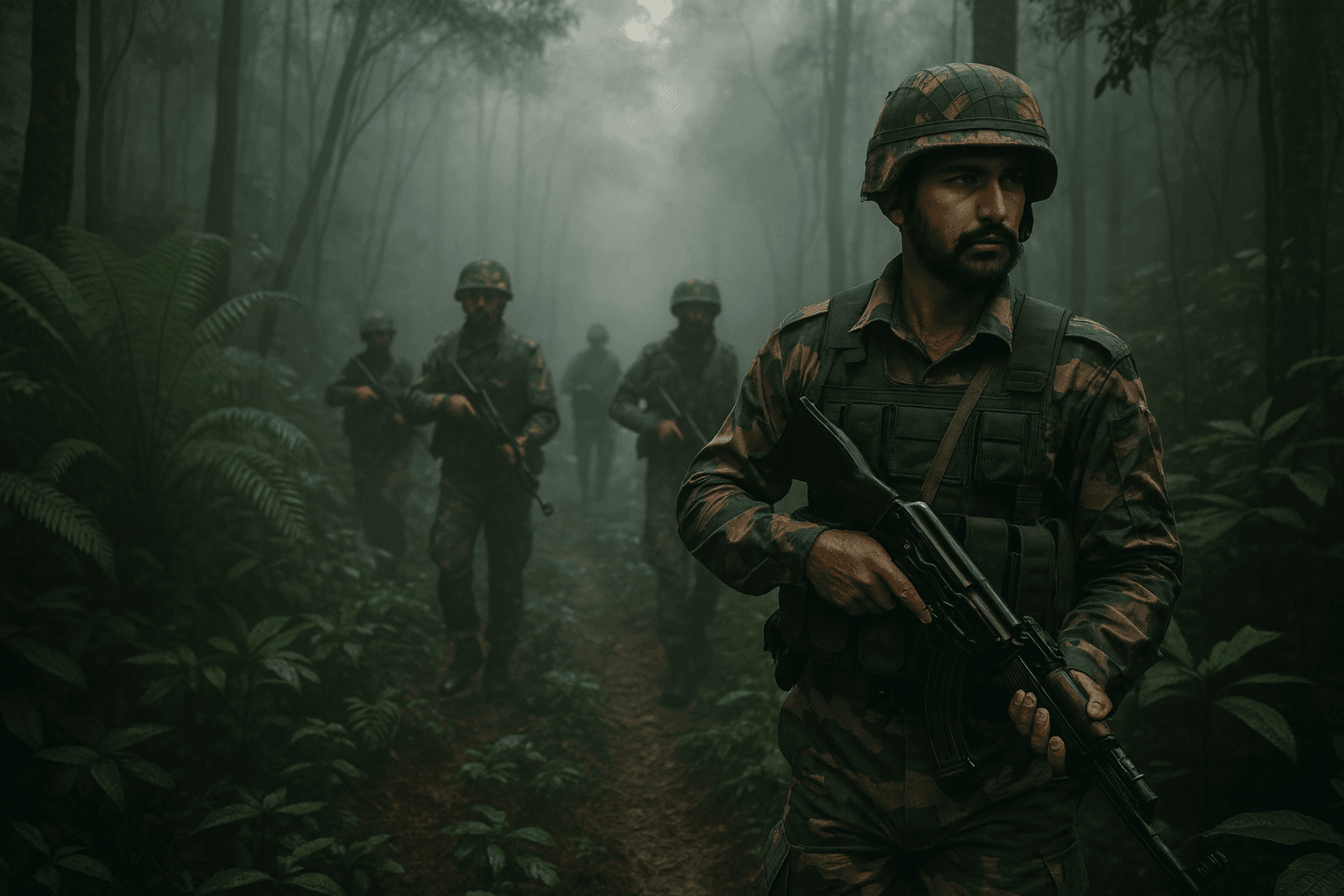India now faces a complex security environment where conventional threats are merging with irregular challenges. From Chhattisgarh’s jungles to cyberspace, India’s security dilemmas reflect global conflict trends. These include a fusion of insurgency, cyber operations, and hybrid aggression—blurring the lines between internal unrest and external threats.
Blurring Lines Between Conventional and Irregular Threats
The evolving spectrum of conflict demands new thinking. Traditional force-on-force battles are giving way to asymmetric engagements that exploit societal fractures, leverage new technologies, and wage wars of influence rather than direct confrontation. In this environment, no single domain is isolated — physical battlegrounds, political arenas, and digital landscapes intersect.
The Need for New Strategic Thinking
This article examines five critical developments that illustrate India’s shifting security landscape: ongoing Maoist insurgency operations, renewed militant clashes in Kashmir, rising concerns over cyber-hybrid threats, intensified international counter-drone cooperation, and rapid technological modernization efforts. Together, they reveal how India — and by extension, many other states — must adapt to an irregular future where guerrilla tactics, hybrid strategies, and cyber-enabled operations converge.
Understanding India’s complex security landscape offers key insights into both regional stability and the global evolution of irregular warfare. India faces a convergence of internal insurgencies, cyber threats, and cross-border hybrid aggression. Studying its response helps illuminate how modern states adapt to layered threats without clear battle lines. These lessons apply beyond South Asia. They are relevant to nations grappling with non-state actors, digital subversion, and urban unrest. India’s experience shows how irregular warfare now spans physical, digital, and psychological domains. It highlights the need for flexible, networked, and whole-of-government strategies. Irregular conflict in the 21st century is not isolated—it is interconnected and adaptive.
Jungle Battles: Maoist Insurgency and the Fight for the Forests
Maoist Irregular Warfare Playbook
The Maoist insurgency, known locally as the Naxalite movement, remains one of India’s longest-running internal security threats. Rooted in deep-seated socio-economic grievances, particularly among marginalized tribal populations, the Maoists have waged a decades-long guerrilla war across the so-called “Red Corridor,” a stretch of forested states from Chhattisgarh to Odisha.
Adaptations in Indian Counterinsurgency Tactics
Recent operations, such as the high-profile encounter in Kanker district in April 2025, where over 20 Maoist fighters were killed, highlight both the intensity and adaptability of the conflict. Indian security forces, particularly the Central Reserve Police Force (CRPF) and state police commandos, have shifted tactics toward intelligence-driven raids, rapid reaction units, and better integration of jungle warfare training. These adaptations mirror classical counterinsurgency theory, focusing on the clear, hold, and build phases, with an emphasis on disrupting Maoist logistics and degrading leadership networks.
Fourth-Generation Warfare in the Red Corridor
However, the Maoists continue to exploit terrain advantages, blending into sympathetic rural populations and utilizing rudimentary yet effective ambush tactics. Landmine attacks, sniper engagements, and sabotage of critical infrastructure such as rail lines and telecommunications towers remain core components of their irregular warfare playbook.
Lessons from the Forest Wars
In many ways, the Maoist insurgency represents a low-tech yet highly resilient form of fourth-generation warfare: decentralized, population-centric, and ideologically driven. Indian counterinsurgency efforts face the twin challenge of delivering security while addressing the very socio-economic disparities that feed the insurgency’s narrative.
The fight for the forests highlights a broader lesson in irregular warfare: terrain, grievances, and decentralized resistance can significantly prolong conflicts, even against a state with overwhelming conventional superiority. As India adapts, the Maoist example serves as a case study in the persistence of classic guerrilla warfare strategies in the modern era.
Kashmir: The Enduring Grey Zone Conflict
The contested region of Jammu and Kashmir remains a flashpoint where irregular warfare thrives under the shadow of great power politics. In early 2025, renewed militant activity in the region underscored the enduring volatility, as security forces engaged in multiple clashes with insurgent groups operating out of rural and urban safe havens.
Modern Insurgency Tactics in Kashmir
Unlike the large-scale insurgencies of the late 1990s and early 2000s, today’s Kashmir conflict operates in a grey zone—a space where deniability, decentralized cells, and narrative warfare play outsized roles. Small unit ambushes, sniper attacks, and improvised explosive devices (IEDs) remain staples of militant tactics. However, an important shift has occurred: the increasing use of local recruits who blend more seamlessly into the civilian population, making detection and disruption harder for Indian forces.
Blurring of Civilian and Combatant Lines
Militant groups exploit both terrain and political sentiment, aiming to provoke heavy-handed responses that can inflame local grievances. In this way, insurgency becomes as much about perception management as battlefield outcomes—a hallmark of modern irregular conflicts globally.
India’s counterinsurgency efforts have evolved, incorporating improved intelligence networks, a layered security grid, and targeted counter-messaging campaigns aimed at deradicalization. However, the challenge remains complex. The line between combatant and civilian is often deliberately blurred, and external support from sympathetic foreign actors—whether material, informational, or ideological—continues to feed instability.
Grey Zone Warfare: Lessons from Kashmir
Kashmir’s enduring conflict offers a critical lesson: irregular warfare thrives in political vacuums, and tactical success on the battlefield must be paired with credible governance, reconciliation efforts, and information dominance to achieve strategic stability.
In the broader context of irregular warfare theory, Kashmir serves as a living example of how insurgency has evolved into a multidimensional struggle, where influence operations, hybrid tactics, and decentralized violence intersect.
Hybrid Threats: Cybersecurity at the Forefront
As kinetic confrontations persist on India’s internal frontiers, a new battlefield has emerged: the cyber domain. Defense Minister Rajnath Singh’s recent remarks in 2025 about the rise of cyberattacks and disinformation campaigns as central elements of hybrid warfare mark a formal recognition of a reality that has been developing for some time: the next great conflicts will not be fought solely on physical terrain.
The Rise of Cyber-Enabled Irregular Warfare
Hybrid warfare blends conventional and irregular methods with information warfare, cyber sabotage, and psychological operations. It seeks to achieve political and strategic objectives without triggering overt military escalation. For India, a nation facing diverse threats from neighboring states and transnational actors, the vulnerability of its critical infrastructure, political processes, and public trust to cyber-enabled operations is a pressing concern.
Cyberattacks as Strategic Harassment
Cyberattacks targeting defense networks, transportation systems, and financial sectors have become a form of strategic harassment. Disinformation campaigns, particularly those aimed at sowing ethnic and religious divisions, illustrate how adversaries seek to weaken cohesion and credibility from within. Unlike traditional insurgencies, these attacks can be launched remotely, anonymously, and with plausible deniability, complicating attribution and retaliation.
India’s Cyber Defense Initiatives
In this environment, India has begun prioritizing the hardening of its cyber defenses. Initiatives include establishing specialized cyber commands, investing in indigenous cybersecurity technologies, and building public-private partnerships to secure vital networks. Information dominance—previously a supporting element of physical campaigns—is now a domain of conflict in its own right.
The Cyber Domain as a New Irregular Battlefield
From the standpoint of irregular warfare theory, the cyber battlefield represents an evolution: sabotage, subversion, and psychological disruption are no longer limited to physical acts; they now occur in digital form on a global scale and at unprecedented speed. The threshold between war and peace is increasingly blurred.
India’s embrace of cybersecurity as a pillar of national defense underscores a broader strategic truth: in modern irregular conflicts, winning the narrative and securing the network are just as vital as controlling the ground.
International Partnerships: Training for the Unseen Battles
Recognizing the complexity of modern conflict, India has increasingly sought to build strategic partnerships that extend beyond traditional force projection. A prime example is the joint military exercise between India and Uzbekistan held in Pune in early 2025. This drill emphasized small-unit tactics, counter-drone warfare, and special forces operations—skills essential for operating in today’s fragmented and technology-saturated battle spaces.
The Importance of Counter-Drone and Small-Unit Training
The choice of focus was no accident. Counter-drone operations, once a niche specialty, are now critical. Unmanned aerial systems (UAS) are a favored tool of both state and non-state actors, offering cheap, deniable methods for surveillance, targeting, and even kinetic strikes. Training to detect, disrupt, and neutralize drone threats reflects India’s growing appreciation for asymmetry at the tactical level.
Adapting Tactical Skills for Irregular Threats
Small-unit operations also reflect broader shifts in the nature of irregular warfare. Success against decentralized insurgent networks or hybrid adversaries often depends on flexible, rapidly deployable teams capable of executing precision strikes and making independent decisions. These skills are transferable across contexts—from Maoist jungles to urban insurgency zones and even cross-border skirmishes.
Building Alliances to Counter Hybrid Threats
Importantly, the India-Uzbekistan exercise highlights a key trend: modern military cooperation is increasingly focusing on irregular threats, not just conventional ones. Nations are preparing together for the unseen battles—fights that involve information warfare, proxy forces, and the manipulation of local grievances rather than massed tank armies.
International collaboration like this is crucial for building resilience against transnational irregular threats. Shared knowledge, interoperability, and mutual capacity building create a broader defensive ecosystem capable of adapting to the unpredictable dynamics of future conflicts.
In irregular warfare, no nation operates in isolation. Alliances, partnerships, and combined training exercises are force multipliers—not merely political signals, but practical steps toward survival and success in a hybridized threat environment.
The Tech Frontier: India’s Race to Modernize Its Defense
In the shifting landscape of modern conflict, technological supremacy is increasingly defining strategic advantage. India’s recent push toward defense modernization—emphasizing artificial intelligence, cyber defense, surveillance systems, and indigenous innovation—signals an urgent recognition: future wars will be won not only through manpower and firepower, but through information dominance, automation, and resilience against digital subversion.
Emerging Technologies and Defense Adaptation
The Defense Research and Development Organisation (DRDO) and private partners are advancing AI-enabled decision systems and autonomous surveillance platforms. They are also developing cyber threat mitigation tools to enhance national resilience. These efforts span battlefield systems, border monitoring, and strategic infrastructure protection. The goal is clear: build a self-reliant, tech-driven defense infrastructure. It must detect and neutralize threats across domains before they escalate into kinetic action. India’s strategy also includes upskilling personnel, expanding digital infrastructure, and promoting civil-military research partnerships to close capability gaps in the evolving threat environment.
Vulnerabilities in a Digitized Military
In practical terms, modernization includes deploying AI to monitor contested regions like Kashmir and automate defenses against drone incursions. Cyber defense is now integrated directly into tactical command chains, not handled separately. Surveillance has shifted from passive collection to active battlefield shaping. Real-time intelligence and predictive analytics disrupt enemy plans before they mature.
Technology as a Double-Edged Sword
However, technological advancements bring their own set of challenges. Dependence on complex systems introduces vulnerabilities, especially to cyber sabotage, electronic warfare, and system spoofing. As India embraces cutting-edge solutions, securing the digital backbone becomes as critical as upgrading kinetic capabilities.
From a perspective of irregular warfare, technology is a double-edged sword. While it can enhance counterinsurgency and hybrid defense efforts, insurgents and state-sponsored proxies are simultaneously innovating, leveraging cheap drones, encrypted communications, deepfakes, and social engineering campaigns. Innovation diffusion ensures that non-state actors will also adapt.
Thus, India’s race toward a tech-driven military is less about futuristic aspirations and more about defensive necessity. In an era where irregular, cyber, and hybrid threats converge, adaptation is a matter of survival.
Conclusion
India’s security challenges in 2025 reflect a broader truth about modern conflict: irregular warfare is now the center of gravity. It is no longer a peripheral concern. From jungle insurgencies and grey zone conflict in Kashmir to cyber-enabled threats, India faces a broad spectrum of irregular pressures. Technological arms races, information warfare, and digitally networked militancy further complicate the landscape. India stands at the forefront of global trends in resistance and irregular warfare, where tactical disruptions create strategic consequences. Its ability to adapt across military, cyber, and civil domains will shape both national security and regional stability.
Interconnected Battlefields: Physical, Political, Digital
Each battlefield—physical, political, and digital—intertwines with the others in complex, reinforcing ways. Maoist insurgents exploit terrain, local networks, and social grievances. Militants in Kashmir weaponize perception, narrative, and community fear to destabilize legitimacy. Cyber attackers strike infrastructure and public trust, often during moments of national vulnerability. Drones and decentralized operations continue to reshape the tactical landscape. Technological modernization accelerates, but it must keep pace with the adaptability and innovation of asymmetric threats. India’s adversaries increasingly blend methods, shifting between domains to stay unpredictable and deniable. Effective responses now demand multi-domain coordination, rapid learning, and resilience that spans institutions, communities, and digital ecosystems.
India’s Lessons for Global Conflict Evolution
India’s experience offers valuable lessons for militaries, policymakers, and resistance movements around the world. Success now requires more than superior firepower alone. It demands agility, resilience, and information dominance across every level of conflict. Forces must be able to fight irregularly across domains—land, cyber, information, and influence—often simultaneously. Adversaries are adaptive, networked, and opportunistic. Winning requires not just technology or tactics but also narrative control, rapid decision-making, and partnerships that span military, civilian, and digital actors. India’s evolving response underscores the future of warfare: integrated, irregular, and fought as much in perception as in terrain.
Adaptation as the Key to Future Success
As lines between insurgency, sabotage, subversion, and hybrid warfare blur, the speed of adaptation matters more than force size. Those who adapt fastest—not those with the largest armies—will shape the future of conflict. India’s current battles are not isolated events. They are warning signs pointing toward the wars of tomorrow.
DISCLAIMER: Links included might be affiliate links. If you purchase a product or service with the links that I provide I may receive a small commission. There is no additional charge to you.





Leave a Reply